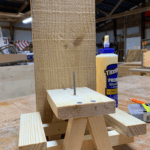Are you struggling with the task of removing scotch tape from woodwork? Whether it’s an accidental tape residue or a stubborn adhesive, this common issue can be frustrating to deal with. In this article, we will explore how to remove scotch tape from woodwork efficiently and effectively, without causing damage to the surface. From understanding the challenge to gathering the right tools and materials, we have got you covered.
Removing scotch tape from woodwork requires careful attention and the use of appropriate techniques to avoid any potential damage. Understanding the nature of the problem is crucial in addressing it properly. With the right strategies and methods, you can ensure a clean and pristine wood surface after tape removal. Whether it’s on furniture, floors, or any other wooden surfaces, we will guide you through the process step by step.
In the following sections, we will discuss the tools and materials needed for this task, provide a detailed step-by-step guide for effective removal, share useful tips and tricks for easier tape removal, highlight common mistakes to avoid during the process, explore alternative methods for stubborn residue, and suggest preventative measures to avoid future issues with scotch tape on woodwork. Stay tuned for valuable insights on tackling this challenging issue.
Tools and Materials Needed
When it comes to removing scotch tape from woodwork, having the right tools and materials on hand can make the process much smoother and more effective. One of the most important items you will need is a hairdryer or heat gun. Applying heat to the tape will help soften the adhesive, making it easier to peel off without damaging the woodwork.
In addition to a hairdryer or heat gun, you will also need a plastic scraper or a credit card to gently lift the tape from the wood surface. Using a metal scraper or sharp tool can cause scratches, so it’s important to use something with a softer edge. You may also want to have some rubbing alcohol or adhesive remover on hand to help dissolve any stubborn residue left behind by the tape.
Other materials that may come in handy include a soft cloth for wiping away any leftover adhesive, as well as some mild soap and water for cleaning the area afterwards. By gathering these tools and materials before you begin tackling the task of removing scotch tape from woodwork, you can ensure that you are well-prepared for the job ahead.
When dealing with scotch tape on woodwork, having these tools and materials at your disposal can make all the difference in successfully removing the tape without causing damage to the wood surface. In the next section, we will provide detailed step-by-step instructions on how to effectively use these tools and materials to remove scotch tape from woodwork with ease.
Step-by-Step Guide
Removing Scotch tape from woodwork can be a challenging task, as the adhesive residue can stick to the wood surface and cause damage if not properly addressed. However, with the right approach and techniques, it is possible to effectively remove the tape without causing any harm to the wood. In this section, we will provide detailed step-by-step instructions on how to remove scotch tape from woodwork without damaging it.
To successfully remove scotch tape from woodwork, you will need the following tools and materials:
- Soft cloths
- Mild dish soap
- Warm water
- Rubbing alcohol or vinegar
- Plastic putty knife or credit card
Step 1: Prepare the Surface
Before attempting to remove the scotch tape, it is important to prepare the surface by cleaning it with a soft cloth dampened with mild dish soap and warm water. This will help loosen any dirt or debris around the tape residue, making it easier to remove.
Step 2: Gently Peel Off the Tape
Using a plastic putty knife or credit card, gently peel off as much of the scotch tape as possible without applying too much force. Be careful not to scratch or damage the wood surface during this process.
Step 3: Remove Residue With Rubbing Alcohol or Vinegar
If there is any sticky residue left on the woodwork after peeling off the tape, moisten a soft cloth with rubbing alcohol or vinegar and gently dab at the residue until it begins to lift off. Avoid using excessive force to prevent damaging the wood.
By following these step-by-step instructions, you can effectively remove scotch tape from woodwork without causing any damage. Remember to always proceed with caution and test any cleaning solutions on a small inconspicuous area of the wood before applying them to larger surfaces.
Tips and Tricks
Removing scotch tape from woodwork can be a frustrating and delicate process, but with the right tips and tricks, it can become much easier and more effective. Here are some proven methods for successfully removing tape residue from wood surfaces:
1. Heat method: Using a hairdryer or heat gun, gently warm up the tape residue to soften it. Once the adhesive becomes pliable, carefully peel off the tape using a plastic scraper or your fingers. Be sure to test this method in an inconspicuous area first to ensure that the heat won’t damage the wood.
2. Oil-based solvents: Apply a small amount of olive oil, coconut oil, or even mayonnaise onto the leftover tape residue. Let it sit for a few minutes to allow the oil to penetrate and loosen the adhesive. Then, gently rub the area with a soft cloth to remove the residue.
3. Alcohol or vinegar solution: Mix equal parts of rubbing alcohol or white vinegar with water and apply it to the tape residue using a soft cloth. Allow it to sit for a few minutes before gently scraping off the softened adhesive with a plastic scraper.
By following these tips and tricks, you can effectively remove scotch tape from woodwork without causing any damage to the surface.
Additionally, here are some alternative methods you can consider if these techniques don’t work for your specific situation:
– Seeking professional help if the residue is particularly stubborn or if you’re unsure about handling the removal process yourself.
With these methods in mind, removing scotch tape from woodwork can be done effectively and without causing any harm to your furniture or fixtures.
Common Mistakes to Avoid
When it comes to removing Scotch tape from woodwork, there are some common mistakes that people often make, resulting in damage to the wood or difficulty in completely removing the tape residue. It’s important to be aware of these pitfalls and to know how to avoid them in order to successfully remove the tape without causing any harm to the wood surface.
One common mistake to avoid is using sharp tools or abrasive materials to scrape off the tape residue. While it may seem like a good idea to use a razor blade or sandpaper to quickly get rid of the stubborn adhesive, this can actually scratch or gouge the wood, leading to more damage. Instead, opt for gentle methods like using a plastic scraper or applying a mild adhesive remover specifically designed for use on wood surfaces.
Another pitfall to watch out for is using excessive force when trying to peel off the tape. Pulling too hard can not only tear the tape, making it even more difficult to remove, but it can also cause splinters or cracks in the wood. Take your time and use a gentle touch when peeling off the tape, and if necessary, apply heat with a hairdryer on low setting beforehand to soften the adhesive.
Finally, avoid leaving tape residue on the wood for too long before attempting removal. The longer the adhesive sits on the surface, the harder it becomes to remove. This can result in more time and effort being needed for successful removal. To prevent this issue, address any taped areas as soon as possible and follow proper removal techniques.
| Common Mistakes | How to Avoid Them |
|---|---|
| Using sharp tools | Use plastic scraper or mild adhesive remover |
| Using excessive force | Apply heat with hairdryer and peel gently |
| Leaving residue for too long | Address taped areas promptly and follow proper removal techniques |
Alternative Methods
Sometimes traditional methods for removing scotch tape from woodwork may not be effective, especially if the tape has been stuck for a long time or in a high-traffic area. In these cases, alternative methods can be explored to tackle the stubborn tape residue without causing damage to the woodwork. Here are some alternative options to consider:
Use Heat
Applying heat to the tape residue can help soften it, making it easier to remove. You can use a hairdryer on a low setting to gently warm up the tape residue. Once it becomes soft and pliable, carefully peel it off using a plastic scraper or your fingers. Be cautious not to apply too much heat to avoid damaging the woodwork.
Oil-Based Solvents
Another option is to use an oil-based solvent such as WD-40 or cooking oil. Apply a small amount of the solvent onto the tape residue and let it sit for a few minutes to penetrate the adhesive. Then, gently rub the residue with a soft cloth until it starts to loosen. Wipe away any excess solvent and residue with a clean cloth.
Vinegar Solution
A vinegar solution can also be effective in breaking down stubborn tape residue. Mix equal parts of white vinegar and water in a spray bottle and spritz it onto the affected area. Allow it to sit for several minutes before wiping away the softened residue with a damp cloth. The acidity of the vinegar helps dissolve the adhesive, making removal easier.
These alternative methods provide additional options for removing stubborn scotch tape from woodwork without causing damage. It’s essential to test each method on an inconspicuous area of the woodwork first to ensure that it does not cause any discoloration or damage. By being patient and using gentle techniques, you can successfully remove even the most stubborn tape residue from your wood surfaces.
Additionally, always remember how important it is before trying any method is testing these solutions directly on your woodwork before proceeding further on larger surfaces.
Preventative Measures
Woodwork can often fall victim to the damaging effects of Scotch tape. Whether it’s from hanging decorations, securing posters, or any other reason, removing Scotch tape from woodwork can be a challenging task. In this section, we will discuss some preventative measures to help you avoid future tape-related issues.
Choose the Right Tape
One way to prevent future tape-related issues is by selecting the right type of tape for your woodwork. Make sure to use low-adhesive or painter’s tape when working with wood surfaces, as these types of tapes are designed to be less aggressive and are less likely to cause damage upon removal.
Surface Preparation
Properly preparing the surface before applying tape can also help prevent issues with its removal later on. Ensure that the woodwork is clean and free from any dust or debris before applying the tape. This will help the adhesive adhere better to the surface and make it easier to remove without leaving behind any residue.
Use Alternative Methods
In situations where you need to secure items to woodwork, consider using alternative methods such as hooks, clips, or removable adhesive strips instead of traditional Scotch tape. These alternatives are designed to be easily removable without causing damage or leaving behind any residue on the woodwork.
By implementing these preventative measures, you can reduce the likelihood of encountering stubborn Scotch tape residue on your woodwork in the future. Taking these steps will ultimately save you time and effort in having to figure out how to remove scotch tape from woodwork effectively.
Conclusion
In conclusion, knowing how to remove scotch tape from woodwork is essential for maintaining the quality and appearance of your wooden surfaces. By following the step-by-step guide and utilizing the right tools and materials, you can effectively remove tape residue without causing damage to the woodwork. Additionally, implementing preventative measures can help avoid future tape-related issues, ultimately saving you time and effort in the long run.
It’s important to remember that taking the time to properly remove scotch tape from woodwork not only preserves the aesthetic appeal of your wooden surfaces but also prevents any potential damage that may occur from improper removal techniques. The tips and tricks provided offer proven methods for easier and more effective tape removal, ensuring that you can tackle this task with confidence.
Furthermore, exploring alternative methods and being aware of common mistakes to avoid will equip you with the knowledge needed to address any stubborn tape residue effectively. By understanding the challenge of removing scotch tape from woodwork and applying these proper removal techniques, you can maintain the beauty and integrity of your wooden surfaces for years to come.
Frequently Asked Questions
How Do You Get Scotch Tape Off of Wood?
Removing Scotch tape from wood can be done by using a hairdryer to warm up the adhesive, making it easier to peel off. Gently scraping the residue with a dull knife or tool can also help remove the tape without damaging the wood.
What Dissolves Scotch Tape?
There are several substances that can dissolve Scotch tape, such as rubbing alcohol, vinegar, or even lighter fluid. These solvents work to break down the adhesive, making it easier to wipe or peel off.
How Do You Remove Dry Scotch Tape?
Dry Scotch tape can be removed by using a combination of heat and gentle scraping. By warming up the tape with a hairdryer and then carefully peeling it off, followed by gentle scraping with a dull tool, the residue can be removed without causing damage to the surface.

Hi everyone! I’m a woodworker and blogger, and this is my woodworking blog. In my blog, I share tips and tricks for woodworkers of all skill levels, as well as project ideas that you can try yourself.





